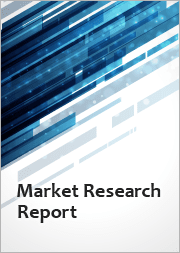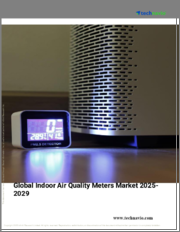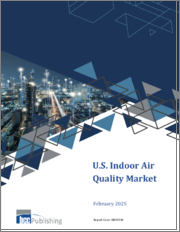
|
시장보고서
상품코드
1642862
상업 빌딩 실내 공기질(IAQ) : 세계 시장 분석과 예측(2024-2033년)Indoor Air Quality in Commercial Buildings: Global Commercial Indoor Air Quality Market Analysis and Forecasts, 2024-2033 |
||||||
세계 상업 빌딩 실내 공기질(IAQ) 시장은 강화된 규제 기준과 기술 발전에 힘입어 향후 10년간 안정적인 성장이 예상됩니다. 열악한 IAQ와 호흡기 건강 문제와의 연관성에 대한 우려가 커지면서 가습기/제습기, 열회수형 환기장치(HRV) 및 에너지회수형 환기장치(ERV), 공기청정기, 센서 등의 IAQ 기술은 병원, 교육기관, 사무실, 창고, 소매점 등 모든 종류의 상업 빌딩 소유주 및 거주자에게 우선순위가 되고 있습니다.
상업 빌딩용 IAQ 기술 시장의 가장 큰 촉진요인은 건강에 대한 인식이며, COVID-19 이후 IAQ가 건강에 미치는 영향에 대한 일반 대중의 이해도가 높아지면서 상업 빌딩의 IAQ 기술 개선에 대한 수요가 증가하고 있습니다. EPBD (Energy Performance of Buildings Directive) 지침과 같은 건축 기준은 고객 만족도를 높이고, 거주자의 안전과 건강을 보장하며, 기업의 지속가능성 목표를 달성하기 위해 기업들에게 건물 인증을 요구하고 있습니다. IAQ 모니터링, 센싱, 첨단 환기 시스템의 기술 혁신과 같은 기술 발전은 보다 에너지 효율적인 솔루션을 만들어내고 있으며, 특히 북미, 유럽, 아시아태평양에서의 도입 확대에 기여하고 있습니다. 성장에 대한 도전과제로는 높은 초기 비용과 지역 간 규제 부족, 특히 다국적 제조업체와 공급자에게는 세계 규제 불일치가 큰 도전이 되고 있습니다.
세계의 상업 빌딩 실내 공기질(IAQ) 시장을 조사했으며, 시장 개요, 시장 촉진요인과 과제, 경쟁 상황, 시장 규모 추정 및 예측, 신축/개보수 건물·기술 유형·지역별 분석, 시장 진입을 위한 제언 등의 정보를 정리하여 전해드립니다.
목차
제1장 주요 요약
- 시장 개요
- 시장 성장 촉진요인과 장벽
- 세계 시장 하이라이트
제2장 시장 문제
- 시장 성장 촉진요인
- 기술의 진보
- 건축 기준과 인증
- 기업의 지속가능성에 대한 대처와 목표
- 건강과 웰니스 의식
- 직원 경험과 테넌트 유지
- 시장 장벽
- 높은 초기 비용
- 규제와 표준화 문제
- 유지보수와 운영상 과제
- 교육과 의식의 결여
- 개선과 통합의 복잡성
- 가격
제3장 산업 밸류체인
- 시장 이해관계자
- 경쟁 구도
- M&A
제4장 시장 예측
- 조사 방법
- 세계 시장 예측
- 건설 유형
- 지역 예측
- 북미
- 유럽
- 아시아태평양
- 라틴아메리카
- 중동 및 아프리카
제5장 결론과 제안
- 3개 항목의 주요 요점
- 추천사항
- 정책 입안자
- IAQ 기술 제조업체 및 프로바이더
- 빌딩 관리자 및 소유자
제6장 두문자어 및 약어 리스트
제7장 목차
제8장 도표
제9장 조사 범위·정보 출처와 조사 방법·주석
ksm 25.02.26The global market for air quality technologies in commercial buildings is expected to experience steady growth in the next 10 years, fueled by tightening regulatory standards and technological advances. As concerns about the connection between poor indoor air quality (IAQ) and respiratory health issues have risen, IAQ technologies-such as humidifiers/dehumidifiers, heat recovery ventilators (HRV) and energy recovery ventilators (ERV), air purifiers, and sensors-have become a priority for building owners and occupants in all commercial building types, including hospitals, educational institutions, offices, warehouses, and retail spaces.
The largest driver of the commercial IAQ technologies market is health awareness, prompted by the public's understanding of IAQ's impact on health, which surged after the COVID-19 pandemic, driving the demand for improved IAQ technologies in commercial buildings. Building standards, such as WELL and Europe's Energy Performance of Buildings Directive (EPBD) have pressured businesses to seek building certifications so that they can improve customer satisfaction, help ensure occupant safety and health, and meet corporate sustainability targets. The EPBD applies to existing infrastructure where the need for retrofitting to meet IAQ standards is significant. Technological advances, such as innovations in IAQ monitoring, sensing, and advanced ventilation systems, are creating more energy efficient solutions, helping to increase adoption especially in North America, Europe, and Asia Pacific. Barriers to growth include high upfront costs and the lack of regulatory mandates across regions; global inconsistencies in regulations, especially for multinational manufacturers and providers, pose significant challenges.
This Guidehouse Insights research report examines the global market for air quality technologies and devices in commercial buildings. Forecasts for commercial IAQ equipment, segmented by newly constructed and retrofitted buildings and technology type, cover the 10-year forecast period of 2024-2033.
Table of Contents
1. Executive Summary
- 1.1 Market Overview
- 1.2 Market Drivers and Barriers
- 1.3 Global Market Highlights
2. Market Issues
- 2.1 Introduction
- 2.2 Market Drivers
- 2.2.1 Technological Advances
- 2.2.2 Building Standards and Certifications
- 2.2.3 Corporate Sustainability Initiatives and Goals
- 2.2.4 Health and Wellness Awareness
- 2.2.5 Employee Experience and Tenant Retention
- 2.3 Market Barriers
- 2.3.1 High Initial Costs
- 2.3.2 Regulatory and Standardization Issues
- 2.3.3 Maintenance and Operational Challenges
- 2.3.4 Lack of Education and Awareness
- 2.3.5 Complexities in Retrofits and Integration
- 2.4 Pricing
3. Industry Value Chain
- 3.1 Market Stakeholders
- 3.2 Competitive Landscape
- 3.2.1 Merger & Acquisition Activities
4. Market Forecasts
- 4.1 Methodology
- 4.2 Global Market Forecast
- 4.2.1 Construction Type
- 4.3 Regional Forecasts
- 4.3.1 North America
- 4.3.2 Europe
- 4.3.3 Asia Pacific
- 4.3.4 Latin America
- 4.3.5 Middle East & Africa
5. Conclusions and Recommendations
- 5.1 Three Big Takeaways
- 5.2 Recommendations
- 5.2.1 Policymakers
- 5.2.2 IAQ Technology Manufacturers and Providers
- 5.2.3 Building Managers and Owners



















